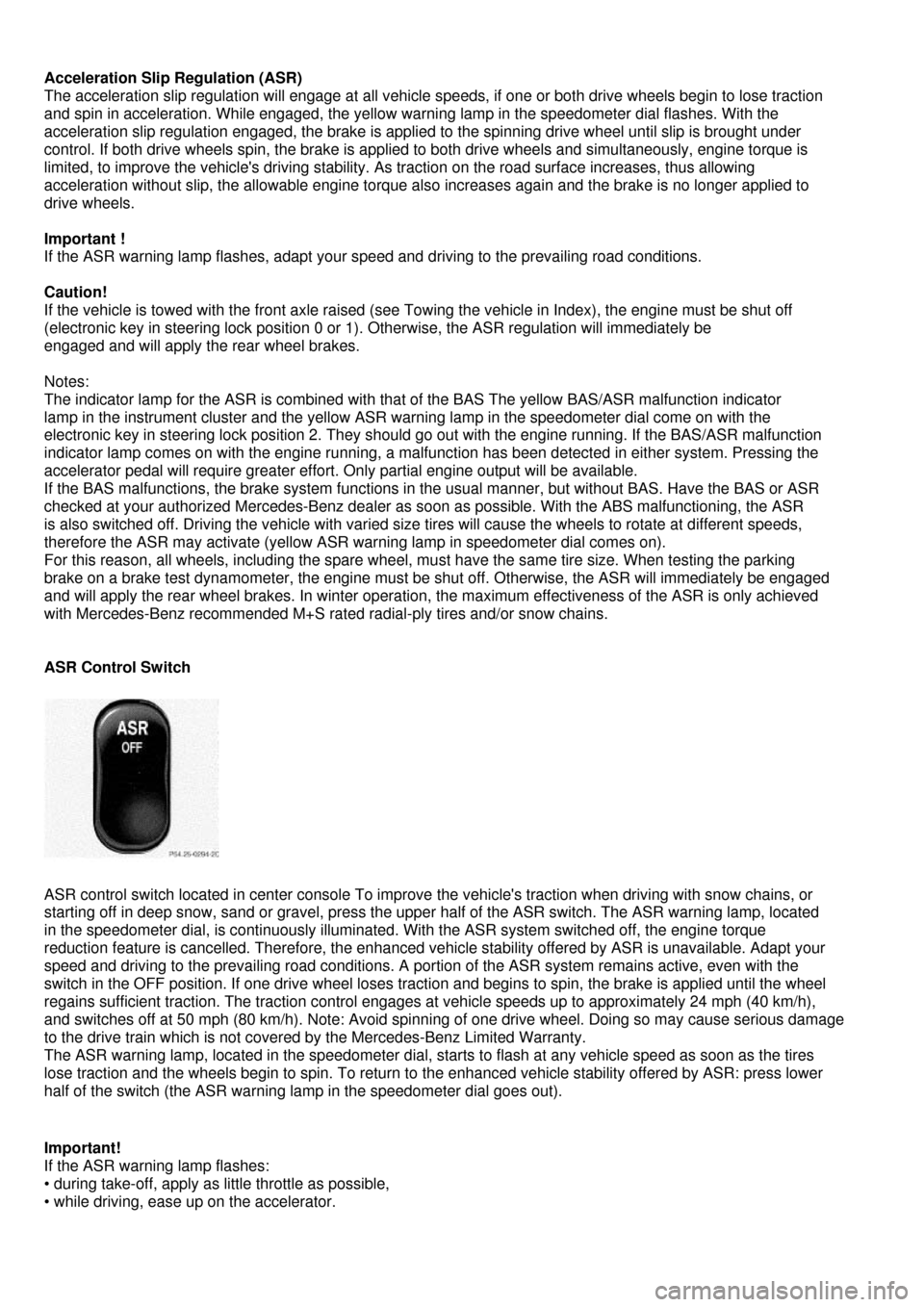lamp MERCEDES-BENZ C-Class 2000 W202 Owner's Guide
[x] Cancel search | Manufacturer: MERCEDES-BENZ, Model Year: 2000, Model line: C-Class, Model: MERCEDES-BENZ C-Class 2000 W202Pages: 130, PDF Size: 2.43 MB
Page 67 of 130

Drinking and Driving
Warning !
Drinking and driving can be a very dangerous combination. Even a small amount of alcohol or drugs can
affect your reflexes, perceptions and judgement. The possibility of a serious or even fatal accident is
sharply increased when you drink and drive. Please don't drink and drive or allow anyone to drive after
drinking.
Parking Brake
To engage, firmly depress parking brake pedal. When the electronic key is in steering lock position 2, the brake
warning lamp in the instrument cluster should come on brightly. To release the parking brake, pull handle on
instrument panel. The brake warning lamp in the instrument cluster should go out. A warning sounds, if you start
to drive without having released the parking brake. Also see Brake Warning Lamp Test in Index.
Driving Off
Apply the service brakes to test them briefly after driving off. Perform this procedure only when the road is clear
of other traffic. Warm up the engine smoothly. Do not place full load on the engine until the operating temperature has
been reached. When starting off on a slippery surface, do not allow one drive wheel to spin for an extended period
with the ASR or ESP switched off. Doing so may cause serious damage to the drive train which is not covered by
the Mercedes - Benz Limited Warranty.
Warning !
Keep driver's foot area clear at all times. Objects stored in this area may impair pedal movement.
Page 69 of 130

Important !
Coasting the vehicle, or driving for any other reason with selector lever in "N" can result in transmission damage
that is not covered by the Mercedes-Benz Limited Warranty.
D - The transmission automatically upshifts through 5th gear. Position "D" provides optimum driving characteristics
under all normal operating conditions.
4 - Upshift through 4th gear only.
Suitable for performance driving. To shift from position "D" to "4", push selector lever to the left.
3 - Upshift through 3rd gear only.
Suitable for moderately steep hill s. Since the transmission does not shift hi gher than 3rd gear, this gear selection
will allow use of the engine's braking power downhill.
2 - Upshift through 2nd gear only.
For driving in mountainous regions or under extreme operating conditions. This gear selection will allow use of the
engine's braking power when descending steep grades.
1 - In this position, the engine's braking effect is utilized by shifting into 1st gear.
Use this position while descending very steep or l engthy downgrades and only at speeds below 40 mph (60
km/h).
Important !
With selector lever in position "D", "4" or "3", upshifting from 1st to 2nd to 3rd gear is delayed depending on vehicle
speed and engine temperature. This allows the catalytic converter to heat up more quickly to operating temperatures.
During the brief warm-up period this delayed upshift and increased engine noise might be perceived as a malfunction.
However, neither the engine nor transmission are negatively affected by this mode of operation.
The delayed upshift is effective with vehicle speeds below 31 mph (50 km/h) at partial throttle and engine
temperatures below 95°F (35°C). To avoid overrevving the engi ne when the selector lever is moved to a lower driving
range, the transmission will not shift to a lower gear, if the engine's speed limit would be exceeded. In this case there
will be no downshift, even when the vehicle speed reaches t he engine's speed limit of that gear, e.g. by applying the
service brakes. Continue driving in the usual manner. The transmission will then shift down automatically.
To prevent the engine from laboring at low RPM when driv ing uphill gradients or with your vehicle heavily loaded, the
automatic transmission will downshift when necessary to maintain engine RPM within the best torque range.
Warning!
On slippery road surfaces, never downshift in order to obtain braking action. This could result in drive wheel
slip and reduced vehicle control. Your vehicle's AB S will not prevent this type of loss of control.
Warning !
On slippery road surfaces, never downshift in order to obtain braking action. This could result in rear
wheel slip and reduced vehicle control. Your vehicle' s ABS will not prevent this type of loss of control.
Maneuvering
To maneuver in tight areas, e.g. when pulling into a parki ng space, control the vehicle speed by gradually releasing
the
brakes. Accelerate gently and never abruptly step on the ac celerator. To rock a vehicle out of soft ground (mud or
snow),
alternately shift from forward to revers e, while applying slight partial throttle. Rocking a vehicle free in this manner
may
cause the ABS malfunction indicator lamp to come on. Turn off and restart the engine to clear the malfunction
indication.
Stopping
For brief stops, e.g. at traffic lights, leave the transmission in gear and hold vehicle with the service brake. For longer
stops with the engine idling, shift into "N" or "P" and hold the vehicle with the service brake. When stopping the
vehicle
on an uphill gradient, do not hold it with the accelerator, use the brake. This avoids unnecessary transmission heat
build up.
Warning !
Getting out of your vehicle with the selector lever not fully engaged in position "P" is dangerous. Also,
when parked on an incline, position "P" alone may not prevent your vehicle from moving, possibly hitting
people or objects. Always set the parking brake in a ddition to shifting to position "P". When parked on
an incline, also turn front wheel against curb.
Page 70 of 130

Program Mode Selector Switch
The transmission is provided with a selector switch for Standard "S" and Winter/Wet (snow and ice) "W" program
modes.
Important !
Always be certain of the program mode selected since the vehicle driving characteristics change with the selection of
the program mode.
S - Standard mode Press switch on symbol "S". Use this mode for all regular driving. The vehicle starts out in 1st
gear.
Accelerator Operation:
Fast on = depressing the accelerator pedal quickly (not into kickdown position) while driving continuously, rather
than depressing the accelerator pedal in the usual manner, will cause the automatic transmission to shift down
into a lower gear.
This gear shifting process is dependent on the current vehicle speed.
Fast off = there will be no upshift when releasing the accelerator pedal quickly, e.g. using the engine's braking
power during performance driving
W - Winter/Wet (snow and ice) mode Press switch on symbol "W".
The vehicle starts out in 2nd gear, except with selector lever in 1st gear, or with accelerator pedal in kick-down
position. The "W" mode helps to improve traction and driving stability of the vehicle.
The gear shifting process occurs at lower vehicle and engine speeds than in the "S,' program mode.
Important
Dependent on the program mode selector switch position "S" or "W" and the gear selector lever in position "13", the
ratio of power transmission changes.
Emergency Operation (Limp Home Mode)
If vehicle acceleration worsens, or the transmission no longer shifts, the transmission is most likely operating in Limp
Home Mode which engages when there is a malfunction at the transmission. This condition may be accompanied by
the "CHECK ENGINE" malfunction indicator lamp in the instrument cluster coming on.
In this mode only the 2nd gear or reverse gear can be activated.
To engage 2nd gear or reverse:
1. Stop the vehicle.
2. Move selector lever to position "P".
3. Turn off the engine.
4. Wait 10 seconds.
5. Restart the engine.
6. Move selector lever to position "D" (for 2nd gear), or move selector lever
to position "R" (for reverse gear).
Have the transmission checked at your authorized Mercedes-Benz dealer as soon as possible.
Page 72 of 130

Charge Indicator Lamp
Should the charge indicator lamp fail to come on prior to starting when the electronic key is in steering lock position 2
or should it fail to go out after starting or during operati on, this indicates a fault which must be repaired at an
authorized Mercedes-Benz dealer immediately.
If the charge indicator lamp comes on while the engine is ru nning, this may indicate that the poly-V-belt has broken.
Should this condition occur, the poly-V-bel t must be replaced before continuing to operate the vehicle. Otherwise, the
engine will overheat due to an inoperative water pump which may result in damage to the engine.
Do not continue to drive the vehicle with the charge indicator lamp illuminated. Doing so could result in serious engine
damage that is not covered by the Mercedes-Benz Limited Warranty.
Low Engine Oil Level Warning Lamp
With the electronic key in steering lock position 2, the o il level warning lamp comes on. It should go out immediately
when the engine is running.
If the warning lamp does not go out after starting the engi ne, or comes on with the engine running and at operating
temperature, the engine oil level has dropped to approximately the minimum mark on the dipstick.
When this occurs, the warning lamp will first come on intermittently and then stay on if the oil level drops further.
If no oil leaks are noted, continue to drive to the nearest service station where the engine oil should be topped to the
"full" mark on the dipstick with an approved oil.
The low engine oil level warning light should not be ignored. Extended driving with the light illuminated could result in
serious engine damage that is not covered by the Mercedes -Benz Limited Warranty. In addition to the warning lamp,
the engine oil level should be periodically checked with t he dipstick (or via the odometer display - Model C280 and
C43 AMG only), for example during a fuel stop, or before a long trip (see Engine Oil Level, Checking in Index)
Page 73 of 130

Engine Oil Consumption
Engine oil consumption checks should only be made after the break-in period. During the breaking period, higher oil
consumption may be noticed and is normal. Frequent driving at high engine speeds results in increased consumption.
Fuel Reserve and Fuel Cap Placement Warning Lamp
With the electronic key in steering lock position 2, the fuel reserve warning lamp comes on. It should go out
immediately when the engine is running.
If the warning lamp does not go out after starting the engine, or if it comes on while driving, it indicates that the fuel
level is down to the reserve quantity of approximately 2.1 gal (8 liters).
The warning lamp blinks when the fuel c ap is not closed, or a fuel system leak has been detected. Retighten cap and
see if lamp goes out.
If the warning lamp continues to blink after closing the fuel cap correctly, hav e the fuel system checked at your
authorized Mercedes-Benz dealer as soon as possible.
Leaving the engine running and the fuel cap open can cause the "Check Engine" lamp to illuminate).
Tachometer
Red marking on tachometer: Excessive engine speed. Avoid th is engine speed, as it may result in serious engine
damage that is not covered by the Mercedes-Benz Limited Warranty. For engine protection, the fuel supply is
interrupted if the engine is operated within the red marking.
Seat Belt Warning Lamp
With the electronic key in steering lock position 2, the warning lamp comes on, and a warning sounds for a short time
if the drivers seat belt is not fastened. After starting the engine, the warning lamp blinks for a brief period to remind
the driver and passengers to fasten seat belts.
Page 75 of 130

Low Engine Coolant Level Warning Lamp
With the electronic key in steering lock position 2, the warning lamp comes on.
It should go out when the engine is running. If the warning la mp does not go out after starting the engine, or if it
comes on while driving, then the coolant level has dropped below the required level. If no leaks are noticeable and
the engine temperature does not increase, continue to driv e to the nearest service station and have coolant added to
the coolant system (see Index).
The low engine coolant level warning light should not be ignored. Extended driving with the light illuminated may
cause serious engine damage not covered by the Mercedes-Benz Limited Warranty.
In cases of major or frequent minor coolant loss, have t he cooling system checked at your authorized Mercedes-Benz
dealer as soon as possible.
Note:
Do not drive without coolant in the cooling system. T he engine will overheat causing major engine damage. Monitor
the coolant temperature gauge while driving.
Warning !
Do not spill antifreeze on hot engine parts. Antifreeze contains ethylene glycol which may burn if it comes into contact
with hot engine parts. You can be seriously burned.
Low Windshield and Headlamp Washer System Fluid Level Warning Lamp
With the electronic key in steering lock position 2, the warning lamp comes on. It should go out when the engine is
running. If the warning lamp does not go out after starting the engine, or if it comes on while driving, the level of the
reservoir has dropped to approx.1/4 of the total volume. T he reservoir should be refilled with MB Windshield Washer
Concentrate "S" and water (or commercially available premixed windshield washer solvent/antifreeze, depending on
ambient temperature - see Index) at the next opportunity. The reservoir fo r the windshield and headlamp washer
systems is located in the engine compartment.
Page 76 of 130

Exterior Lamp Failure indicator Lamp
With the electronic key in steering lock position 2, an exterior lamp comes on. It should go out when the engine is
running. If the warning lamp does not go out after starting the engine, or if it comes on while driving, this lamp
indicates a failure in the parking lamp, taillamp, stop la mp, or low beam headlamp. If an exterior lamp fails, the
indicator lamp will come on only when that lamp is switched on. If a brake lamp fails, the lamp failure indicator will
come on when applying the brake and stay on until the engine is turned off.
Note:
If additional lighting equipment is installed (e.g. auxiliary headl amps etc.) be certain to connect into the fuse before
the failure indicator monitoring unit in order to avoid damaging the system.
Brake Pad Wear Indicator Lamp
With the electronic key in steering lock position 2, the brake pad wear indicator lamp comes on .
It goes out when the engine is running.
If the indicator lamp lights up during braking, this indica tes that the brake pads are worn down. Have the brake
system checked at your authorized Mercedes- Benz dealer as soon as possible.
Brake Warning Lamp
With the electronic key in steering lock position 2, the brake warning lamp will come on. It should go out when the
engine is running. The brake warning lamp will come on:
• when there is insufficient brake fluid in the rese rvoir (engine running and parking brake released), or
• when the parking brake is set (engine running).
Warning !
Driving with the brake warning lamp illuminated can result in an accident. Have your brake system checked
immediately if the brake warning lamp stays on. Don't add brake fluid before checking the brake system.
Overfilling the brake fluid reservoir can result in sp illing brake fluid on hot engine parts and the brake fluid
catching fire. You can be seriously burned.
If you find that the minimum mark on the brake fluid reserv oir is reached, have the brake system checked for brake
pad thickness and leaks. To test the brake warning lamp, turn electronic key in steering lock to position 2. The brake
warning lamp comes on, and should go out when the engine is running.
Page 78 of 130

Antilock Brake System (ABS)
Important !
The ABS improves steering control of the vehicle during braking maneuvers. Do not pump the brake pedal, rather use
firm, steady brake pedal pressure. Pu mping the brake pedal defeats the pur pose for ABS and significantly reduces
braking effectiveness.
The ABS prevents the wheels from locking up above a vehicl e speed of approximately 5 mph (8 km/h) independent of
road surface conditions.
At the instant one of the wheels is about to lock up, a slight pulsation can be felt in the brake pedal, indicating that the
ABS is in the regulating mode. Keep firm and steady pressure on the brake pedal while experiencing the pulsation.
On slippery road surfaces, the ABS will re spond even with light brake pedal pressure because of the increased
likelihood of locking wheels. The pulsating brake pedal can be an indication of hazardous road conditions and
functions as a reminder to take extra care while driving.
ABS Control
The ABS malfunction indicator lamp in the instrument cl uster comes on with the electronic key in steering lock
position 2 and should go out when the engine is running.
If the charging voltage falls below 10 volts, the malfunction indicator lamp comes on and the ABS is switched off.
When the voltage is above this value again, the malfunction indicator lamp should go out and the ABS is operational.
With the ABS malfunctioning, the ASR or ESP, if vehicl e so equipped, are also switched off. Both malfunction
indicator lamps come on with the engine running. If the ABS malfunction indicator lamp does not go out or comes on
while driving, it indicates that the ABS has detected a malfunction and has switched off. In this case, the brake
system functions in the usual manner, but without antilock assistance.
Have the system checked at your authorized Mercedes-Benz dealer as soon as possible.
Warning !
ABS cannot prevent the natural laws of physics from acting on the vehicle, nor can it increase the traction
made available by the road conditions. The ABS ca nnot prevent accidents, including those resulting from
excessive speed in turns, following another vehicle too cl osely, or aquaplaning. Only a safe, attentive, and
skillful driver can prevent accidents. The capabilities of an ABS equipped car must never be exploited in a
reckless or dangerous manner which could jeopardize the user's safety or the safety of others.
Note:
To alert following vehicles to slippery road conditions you discover, operate your hazard warning flashers as
appropriate.
Page 79 of 130

Brake Assist System (BAS)
Warning !
BAS cannot prevent the natural laws of physics from acting on the vehicle, nor can it increase braking
efficiency beyond that afforded by the condition of the vehicle brakes and tires or the traction afforded.
The BAS cannot prevent accidents, including those resulting from excessive speed in turns, following
another vehicle too closely, or aquaplaning. Only a safe, attentive, and skillful driver can prevent accidents.
The capabilities of a BAS equipped car must never be exploited in a reckless or dangerous manner which
could jeopardize the user's safety or the safety of others.
The Brake Assist System is designed to maximize the vehicle's braking capability during emergency braking
maneuvers by having maximum power boost applied to the br akes more quickly in emergency braking conditions
than might otherwise be afforded solely by the driver's braking style. This can help reduce braking distances over
what ordinary driving and braking style might do. The BAS complements the Antilock Brake System (ABS).
To receive the benefit of the system you must apply continuous full braking power during the stopping sequence.
Do not reduce brake pedal pressure.
Once the brake pedal is released, the BAS is deactivat ed The malfunction indicator lamps for the ASR and ESP are
combined with the BAS malfunction indicator lamp.
The BAS/ASR or BAS/ESP malfunction indicator lamp in the instrument cluster come on with the electronic key in
steering lock position 2 and should go out with the engine running.
If the BAS/ASR or BAS/ESP malfunction indicator lamp comes on permanently while the engine is running,
a malfunction has been detected in either system. As a resul t, it is possible that now only partial engine output will be
available, and pressing the accelerator pedal will require more effort. If the BAS malfunctions. The brake system
functions in the usual manner, but wi thout BAS. If the charging voltage falls be low 10 volts, the malfunction indicator
lamp comes on and the BAS is switched off. When the volt age is above this value again, the malfunction indicator
lamp should go out and the BAS is operational. With t he ABS malfunctioning, the BAS, ASR or ESP are also
switched off.
Both malfunction indicator lamps come on with the engine running. Have the BAS, ASR or ESP checked at your
authorized Mercedes-Benz dealer as soon as possible .
Page 80 of 130

Acceleration Slip Regulation (ASR)
The acceleration slip regulation will engage at all vehicle speeds, if one or both drive wheels begin to lose traction
and spin in acceleration. While engaged, the yellow warning lamp in the speedometer dial flashes. With the
acceleration slip regulation engaged, the brake is applied to the spinning drive wheel until slip is brought under
control. If both drive wheels spin, the brake is applied to both drive wheels and simultaneously, engine torque is
limited, to improve the vehicle's driving stability. As traction on the road surface increases, thus allowing
acceleration without slip, the allowable engine torque also increases again and the brake is no longer applied to
drive wheels.
Important !
If the ASR warning lamp flashes, adapt your speed and driving to the prevailing road conditions.
Caution!
If the vehicle is towed with the front axle raised (see Towing the vehicle in Index), the engine must be shut off
(electronic key in steering lock position 0 or 1). Otherwise, the ASR regulation will immediately be
engaged and will apply the rear wheel brakes.
Notes:
The indicator lamp for the ASR is combined with that of the BAS The yellow BAS/ASR malfunction indicator
lamp in the instrument cluster and the yellow ASR warning lamp in the speedometer dial come on with the
electronic key in steering lock position 2. They should go out with the engine running. If the BAS/ASR malfunction
indicator lamp comes on with the engine running, a malfunction has been detected in either system. Pressing the
accelerator pedal will require greater effort. Only partial engine output will be available.
If the BAS malfunctions, the brake system functions in the usual manner, but without BAS. Have the BAS or ASR
checked at your authorized Mercedes-Benz dealer as soon as possible. With the ABS malfunctioning, the ASR
is also switched off. Driving the vehicle with varied size tires will cause the wheels to rotate at different speeds,
therefore the ASR may activate (yellow ASR warning lamp in speedometer dial comes on).
For this reason, all wheels, including the spare wheel, must have the same tire size. When testing the parking
brake on a brake test dynamometer, the engine must be shut off. Otherwise, the ASR will immediately be engaged
and will apply the rear wheel brakes. In winter operation, the maximum effectiveness of the ASR is only achieved
with Mercedes-Benz recommended M+S rated radial-ply tires and/or snow chains.
ASR Control Switch
ASR control switch located in center console To improve the vehicle's traction when driving with snow chains, or
starting off in deep snow, sand or gravel, press the upper half of the ASR switch. The ASR warning lamp, located
in the speedometer dial, is continuously illuminated. With the ASR system switched off, the engine torque
reduction feature is cancelled. Therefore, the enhanced vehicle stability offered by ASR is unavailable. Adapt your
speed and driving to the prevailing road conditions. A portion of the ASR system remains active, even with the
switch in the OFF position. If one drive wheel loses traction and begins to spin, the brake is applied until the wheel
regains sufficient traction. The traction control engages at vehicle speeds up to approximately 24 mph (40 km/h),
and switches off at 50 mph (80 km/h). Note: Avoid spinning of one drive wheel. Doing so may cause serious damage
to the drive train which is not covered by the Mercedes-Benz Limited Warranty.
The ASR warning lamp, located in the speedometer dial, starts to flash at any vehicle speed as soon as the tires
lose traction and the wheels begin to spin. To return to the enhanced vehicle stability offered by ASR: press lower
half of the switch (the ASR warning lamp in the speedometer dial goes out).
Important!
If the ASR warning lamp flashes:
• during take-off, apply as little throttle as possible,
• while driving, ease up on the accelerator.